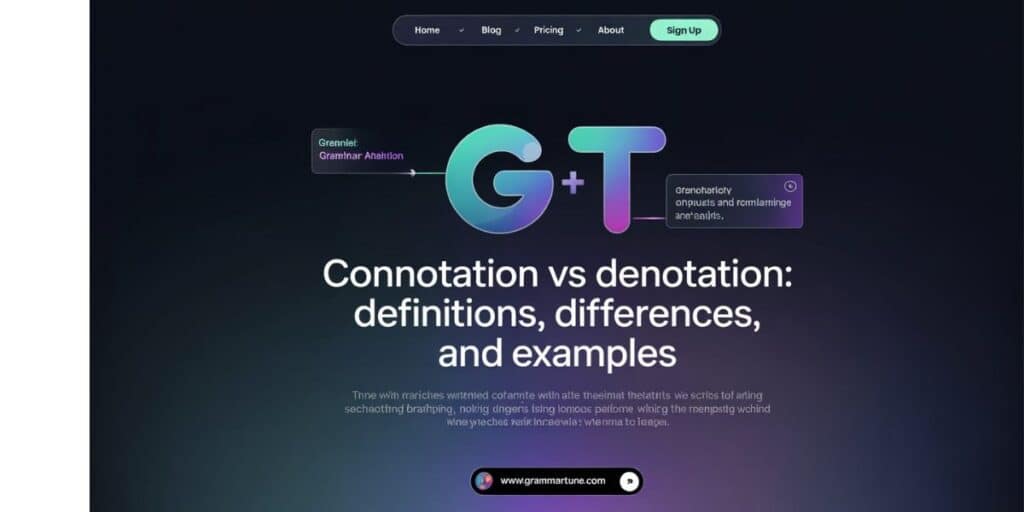The above two concepts that make one deepen the insight on how meaning works with language are denotation and connotation. Denotation refers to the literal or dictionary meaning of the word, while connotation includes the emotional or cultural tones active in the preferred context of the word’s usage.
Knowing the difference can greatly enhance one’s use of communication in writing, advertising, or everyday conversation. Each section of this guide is described very clearly, with ample real-world examples, definitions, and important differences that will be helpful in one setting: with the proper setup, language can be interpreted. So let us see how magic and poetry take over from the prosaic.
Table of contents
📚 Understanding the Basics
- 🔤 Connotation and Denotation Definition
- 🧩 Basis of Connotation vs Denotation
- ⚖️ Difference Between Connotation and Denotation
- 💬 CONNOTATION DEFINITION
- ❓ What is Connotation?
- 🎨 Types of Connotation
- 🔄 Connotative vs Denotative Meaning
- 📘 Connotation Examples
- 📌 TERMS
- 🧸 OBJECTS
- 🎥 Connotation vs Denotation Examples • Rosebud in Cinema
🧠 In-Depth Insights & Application
- 😵💫 Why Is There Confusion?
- 📖 Key Differences Between Connotation and Denotation
- 🧾 Definition vs. Interpretation
- 😍 Literal vs. Emotional Meaning
- 🔐 Fixed vs. Flexible Meaning
- 🗣️ Usage in Communication
- 🌐 Examples in Different Contexts
- 📖 In Literature
- 📢 In Advertising
- 💬 In Daily Conversation
- 🏛️ In Politics
- 📰 In Media and News - 🛠️ How to Use Connotation and Denotation Effectively
- 🧬 Etymology of Connotation and Denotation
- 🌱 Etymology of Connotation
- 🧭 Etymology of Denotation - ❓ FAQs
- 🏁 Conclusion: Connotation vs Denotation
🌟 Connotation and Denotation Definition
Words can carry more than just a simple meaning. Denotation is the literal dictionary definition. Connotation, on the other hand, is the emotional or cultural flavor that tags along.
These two layers of meaning shape how we understand language. Without them, words would feel flat and robotic. Knowing both helps us read between the lines. ✨
Must read: What is the plural of oasis?
📚 Basis of Connotation vs Denotation
Connotation vs denotation stems from how we process language. One focuses on strict facts, the other on feelings. This basis explains why the same word can hit differently in different settings.
For example, “home” denotatively means a place you live. But connotatively, it might suggest warmth, love, or safety. That extra layer changes everything. 🏡
🔍 Difference Between Connotation and Denotation • Connotation vs Denotation
Denotation denotes what the word means; connotations imply what the word may carry. So it is logic against emotion. Denotation is like the skeleton, connotation is like the soul. One is universal, the other personal. That makes language beautiful and tricky. 🎭🎭
🧠 CONNOTATION DEFINITION
Denotation refers to the emotional or cultural associations that are attached with a word. It is not referred to in the dictionary but it is felt basically. This hidden tone gives the words the edge.
E.g., the word “slim” sounds complimentary. The same person when called “skinny” will feel insulted. This is the magic of connotation. 🎯 🎯
💬 What is connotation?
Connotation shapes how a word feels to the reader or listener. It colors our interpretation based on past experiences, tone, and context. One word can spark admiration or disgust.
Take “cheap” versus “affordable.” Same denotation, very different vibes. That’s connotation doing the heavy lifting. 💸🔍
🎨 Types of Connotation:
Well, there is a thing like classifying a connotation into good, bad, or neutral things, which again can affect the way in which one reacts to a word. It can be that subtle, but it will have an impact.
Three adjectives to describe personality-“confident” (good connotation), “arrogant” (bad connotation), and “reserved” (neutral). Connotative difference of acceptable alternatives is why a word can be understood differently. 🗣️⚖️ 🗣️⚖️🗣️⚖️ 🗣️⚖️🗣️⚖️
🔄 Connotative vs Denotative Meaning
Denotative meaning sticks to the facts. Connotative meaning adds emotion and suggestion. Knowing both can improve how you write and speak.
Let’s say you call a place a “shack.” It might just be a small house denotatively, but connotatively it sounds rundown. Word choice speaks volumes. 🏚️📖
📘 Connotation Examples
Now, here are instances of some connotation in real life. The word “childish” carries negative connotations even though its literal definition is child-like. Whereas “youthful” is a very positive term.
Another example: stingy-thrifty. The distinction is there, but they imply different attitudes. Here, the connotation changes our perspective. 💭✅ 💭✅
📌 TERMS
Certain terms come loaded with connotations. Think of “bureaucrat”—cold and slow—or “visionary”—bold and inspiring. These aren’t in the definitions, but we feel them anyway.
Media, culture, and personal history all shape those meanings. That’s why word selection is such a powerful tool. 🗞️💡
🧸 OBJECTS
Even everyday objects can carry connotative meaning. A “rose” might just be a flower, but it can also symbolize love or secrecy. That’s the beauty of language.
Call a car “vintage” instead of “old,” and it sounds special. Words transform how we see things. 🚗🌹
🎥 Connotation vs Denotation Examples • The Meanings of Rosebud, Examined by Cinema Absurdist
In Citizen Kane, “Rosebud” is more than a sled. Denotatively, it’s just an object. But connotatively, it holds a lifetime of lost innocence and longing.
This example from cinema shows how deeply connotation vs denotation can alter meaning. A single word can carry an entire story. 🎬🛷
📖 DENOTATION DEFINITION
Denotation is a word’s exact, literal meaning. It’s what you’d find in the dictionary—plain and straightforward. No emotion, no added flavor—just facts.
When you see the word “snake,” its denotation is simply a reptile. No fear, no symbolism. That’s the clean-cut role of denotation. 🐍📘
❓ What is denotation?
Denotation strips language down to its core. It removes emotional tone and focuses only on the technical meaning. This helps maintain clarity in communication.
Writers often start with denotation, then layer on connotation for depth. It’s the foundation beneath the poetry. Like a blueprint before a building. 🏗️📝
🔬 Characteristics of Denotation:
- Objective and emotion-free
- Universally understood
- Unchanging in context
Denotation doesn’t shift from person to person. “Dog” means the same to everyone in a denotative sense. That consistency keeps language reliable. 🐶🔍
🧾 Denotation Examples
Let’s break it down with clear denotation examples. A “rose” is just a flower, regardless of what it might symbolize. A “lion” is just a big cat.
“Blue” means the color, not sadness. “Book” means a set of printed pages. These are denotative meanings—no interpretation needed. 📚🌹
🧠 Connotation vs Denotation Examples • Homonyms, Examined by D!NG
Some words get tricky—especially homonyms. Take “date.” Denotatively, it could be a fruit or a calendar day. But connotatively, it might mean romance. 🍑💘
In a D!NG-style breakdown, this gets fun. The word “fire” can mean literal flames—or energy and excitement. That’s where connotation vs denotation plays mind games. 🔥🤯
😵💫 Why Is There Confusion?
People often mix up connotation and denotation because they both deal with meaning. But one is surface-level, the other goes deeper. It’s easy to blur the line if you’re not paying attention.
Context makes it even harder. The same word can mean different things depending on tone or place. That’s where the confusion creeps in. 🌀🔤
⚖️ Key Differences Between “Connotation” and “Denotation”
The key differences boil down to precision vs perception. Denotation is black-and-white. Connotation lives in the gray.
Words like “childlike” and “childish” prove it. Same base, different tone. Knowing which one to use matters. 🧒📚
📘 Definition vs. Interpretation
Denotation is the definition—cold, clean, and official. Connotation is how we interpret that word through feelings, culture, or context. It’s all about perception.
For example, “freedom” is defined one way, but interpreted in countless ways. That interpretation is where emotions kick in. 🕊️🧠
You will like: Pre-Existing or Preexisting: Which One is Correct?
😍 Literal vs. Emotional Meaning
With denotation, what you see is what you get. It’s the literal meaning of a word. No extra layers.
Connotation adds that emotional weight. Say “snake” and you might think betrayal, not just a slithery reptile. It’s all about how the word makes you feel. 🐍💔
🔐 Fixed vs. Flexible Meaning
Denotative meanings don’t change—what’s written in the dictionary stays put. They’re fixed and universal. No matter where or when, they stay the same.
But connotative meanings shift with time and culture. “Sick” used to be bad; now it can mean cool. That’s flexibility in language. ⏳🗣️
🗣️ Usage in Communication
In formal or academic writing, denotation keeps things clear and objective. In storytelling or ads, connotation draws you in emotionally. Different goals need different meanings.
Choosing the right one builds stronger messages. It can mean the difference between clarity and confusion. Use wisely. 🎯✍️
🌐 Examples of Connotation and Denotation in Different Contexts
Words don’t live in a vacuum. Their connotation and denotation shift depending on where they’re used. Let’s break it down.
You’ll see the difference everywhere—from novels to newsrooms. The way language works changes with the setting. Here’s how. 🔄📂
📖 In Literature
Writers use connotation to shape mood and meaning. A storm might denotatively be just rain—but connotatively, it could represent conflict or fear. Symbolism is key.
Authors rely on these layers. They make characters richer, and scenes more powerful. Literature breathes through connotation. 🌧️📚
📢 In Advertising
Connotative marketing is emotionally attaching words in the minds of viewers. For example, a “luxurious” hotel sounds much better than a “high-priced” one-even though they mean the same thing.
Not really what they say-however, it is the diction influence. This is it. 🛍️✨ 🛍️✨
💬 In Daily Conversation
You use connotation every day—often without realizing it. Calling someone “assertive” vs. “pushy” sends totally different messages. Word choice says a lot.
Even a compliment can sound shady with the wrong tone. That’s why understanding connotation matters. 🗨️😅
🏛️ In Politics
Politicians choose their words very carefully. Saying “reform” instead of “cutbacks” softens the blow. That’s the strategic connotation at work.
Denotatively, both may mean change. But connotatively, they send different signals to the public. Language is a powerful tool. 🗳️🧩
📰 In Media and News
News outlets lean on connotation to guide how you feel about a story. A protestor might be called an “activist” or a “rioter.” Big difference.
Denotation gives facts, but connotation frames the narrative. That framing influences public opinion. Stay alert. 📰⚖️
🛠️ How to Use Connotation and Denotation Effectively
To communicate clearly, balance denotation and connotation. Use denotative meaning when precision matters—like in legal or technical writing. Save connotation for emotional impact, like storytelling or marketing.
Know your audience. A word’s emotional shade may vary across cultures or age groups. Being intentional with your word choice boosts clarity and connection. 🧠🗣️
🧬 Etymology of Connotation and Denotation
Understanding the roots of these words helps deepen their meaning. Both connotation and denotation come from Latin—but they traveled different paths. Let’s look at where each one began.
Their origins explain how these terms evolved into tools of emotional and literal language. It’s a glimpse into how humans shape meaning. 🏛️📜
🌱 Etymology of Connotation
Connotation comes from the Latin word connotare, meaning “to mark along with.” It combines com- (with) and notare (to note). So it’s about added meaning.
Originally used in logic and philosophy, it described implied attributes. Over time, it became essential in language and literature. 💭🖋️
🧭 Etymology of Denotation
Denotation stems from Latin denotare, meaning “to mark out.” The prefix de- implies emphasis, and notare again means “to note.” Together, it means pointing out directly.
It was used in formal logic to indicate specific references. Now, it’s how we refer to a word’s strict, dictionary meaning. 📘🔎
You will like: Lead or LEED: When to Use Which One?
Conclusion
Denotation is the dictionary meaning of words while connotation refers to the suggestion or emotional association of the word. Thus, the ability of words becomes more powerful by complementary-use of these two forms. One needed proper understanding of both denotation and connotation in order to become a well-versed writer.
For instance, be it when they tell stories, market their products, or simply have conversations with others, distinguishing between these two concepts is very important.Your perspective on language must go beyond semantics to include intonation.
All these subtle nuances, mastered, will allow you to wield the power of effective communication in whatever direction you require.✨🗣️📚✨🗣️📚
FAQ,S
What is the difference between connotation and denotation?
Denotation is the dictionary meaning. Connotation is the emotional or cultural vibe.
Why does connotation matter in writing?
It shapes how readers feel about your words. It adds tone, mood, and depth. ✍️
Can a word have multiple connotations?
Yes! Meaning can change based on culture, context, or even tone of voice.
Is denotation always the same?
Pretty much—denotation is fixed and universal. That’s what keeps language consistent.
Where do we see connotation used most?
In media, ads, politics, and casual speech. It’s everywhere once you notice! 📺🗣️

Joulia, a seasoned wordsmith and grammar enthusiast, brings over a decade of blogging expertise to Grammar Tune. With a keen eye for linguistic precision and a passion for making complex grammar concepts accessible, he has helped thousands of readers enhance their writing skills. His engaging teaching style and practical approach to language learning have made him a trusted voice in the online grammar community.







